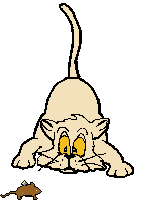|
Feline Diet Transitioning...
If your finicky feline is resisting a diet change,
try these tips! |
 |
Two important factors to consider when implementing any diet change with cats:
- Try to start the process when you have as few "outside" distractions as possible so you can monitor the change process closely
- The best time to implement a diet change is when your cat is healthy and readily eating their old food.
1. BE PATIENT! Go slow; this process can take days, weeks, even months.
2. Meal feeding is best. You control portions and your cat is stimulated by normal hunger sensations to eat. A hungry cat is more willing to try new food. Feed every 8-12 hours only. You may withhold for up to 15-18 hours, but absolutely no longer! Cats need to consume a consistent daily allowance of nutrients to keep their body functioning properly.
3. Exercising your cat before meal time will help stimulate appetite.
4. Pet your cat when he/she is in front of their food dish. Use encouraging words and a soft voice.
5. Canned food should be at room temperature to be most appealing.
6. Turn the dry food into a game. Throw pieces one at a time to stimulate exercise and hunting techniques. (This also helps with obese patients!)
7. Sprinkle something enticing on the new food such as small pieces of tuna, cooked chicken, parmesan cheese, or other treats that your cat loves. Gently push a few in the canned food or mix with dry to get your cat to dig around for it. Even if they pick it out, they are being exposed to the new food.
8. When transitioning from dry to wet, try “dipping” a few kibble pieces into the wet food so your cat gets some of each food with every bite.
9. Also, try crushing a few pieces of kibble into a powder to sprinkle over the canned food.
10. If it does not upset or stress your cat, try rubbing a little of the new canned food on their gums or front paws.
11. For switches to an all wet diet, try increasing their water intake by using flavored waters like tuna, chicken or beef broth, clam juice, or lactose-free cat milk. Make your own tuna water by adding 3 cups of water to a can of tuna. Mash and let it sit for 15 minutes. You can freeze in ice cube trays for longer storage. Heat gently before serving.
12. BE PATIENT! Don’t give up! This is a process!
General Diet Change (old food to new food)
- If your cat is free-fed, meaning there is food left out all day, we strongly recommend switching to meal-based feedings every 8-12 hours. (2-3 times daily). This will allow you to utilize the normal sensation of hunger to help with transition.
- Portion control is important. You will need to either figure out how much your cat has been eating, or follow a recommended feeding guideline. (Usually 1/2 cup per 10lbs of ideal body weight per day.) Divide this total amount into 2-3 smaller meals. Place the food down for 20-30 minutes. Whatever is left after that time, pick up and put away until the next feeding.
- The best way to introduce a new food is to place the old food in a new dish and offer the new food in the cat's regular dish. Offer both dishes for 20-30 minutes; let them choose which food they will eat, and then pick up the bowls.
- Once your cat is familiar with the new diet and is eating it readily, you can begin to decrease the amount of old food by about 25% every few days until the change is complete.
Dry Food to Canned Food Change
- Controlled meal feeding is important in transitioning from dry to wet food. You are much more able to visualize how much your cat is eating and we can use your cat's normal sensation of hunger to work to your advantage. Be patient!
- If your cat is used to getting wet food as a "treat", gradually increase the amount of wet food and decrease the amount of dry, until you have eliminated all of the dry kibble.
- If your cat has never eaten canned/wet food before, it may be a bit challenging to make the switch. Offer both dry kibble in a new bowl and the new wet food in his/her regular feeding dish for 20-30 minutes and let them choose. Remove both bowls and put away. Give fresh or slightly re-heated canned food at each feeding. If your cat readily eats the wet food, you can stop feeding the dry food. If they are resistant to the wet food, only tasting it, try setting down the wet food first for a few minutes. If your cat is hungry and willing to try it, they may surprise you!
- If your cat is extremely resistant to this change, let your cat become a bit hungrier. Offer the canned food at the normal feeding (no dry food), pick it up and offer again in 1-2 hours. If your cat has not eating in 15-18 hours, go ahead and feed a small portion of dry food. DO NOT withhold food for longer than 18 hours. Cat's need to consume a consistent daily allowance of nutrients to keep their body functioning properly. At this point, you may need to slow down your process
Still having problems? Don't hesitate to give us a call!
| 